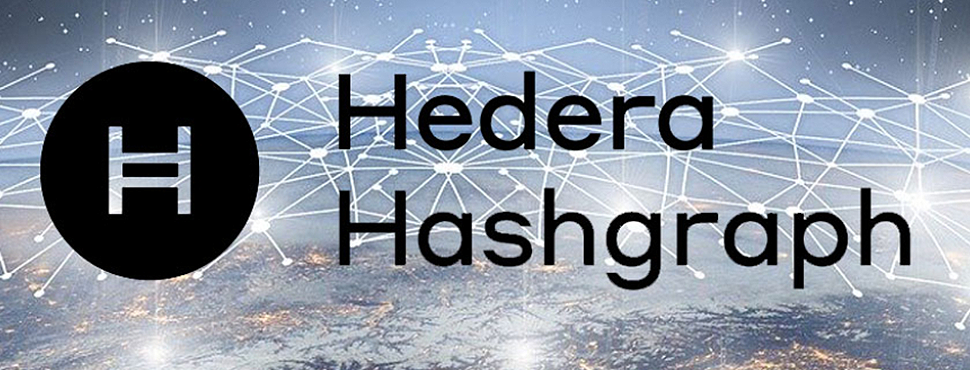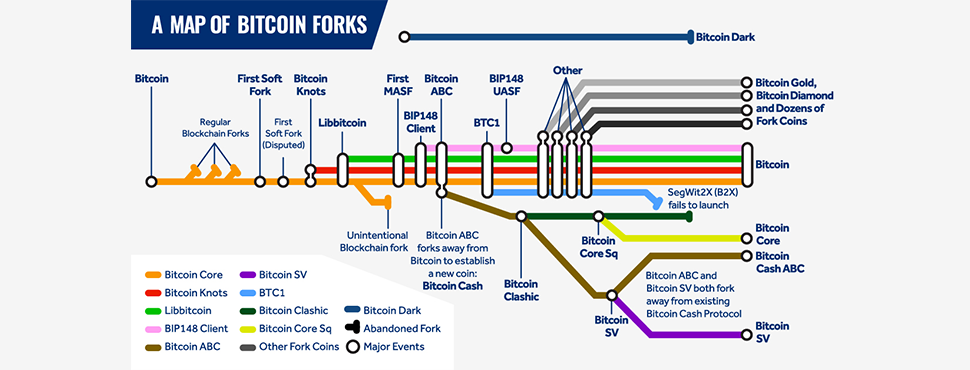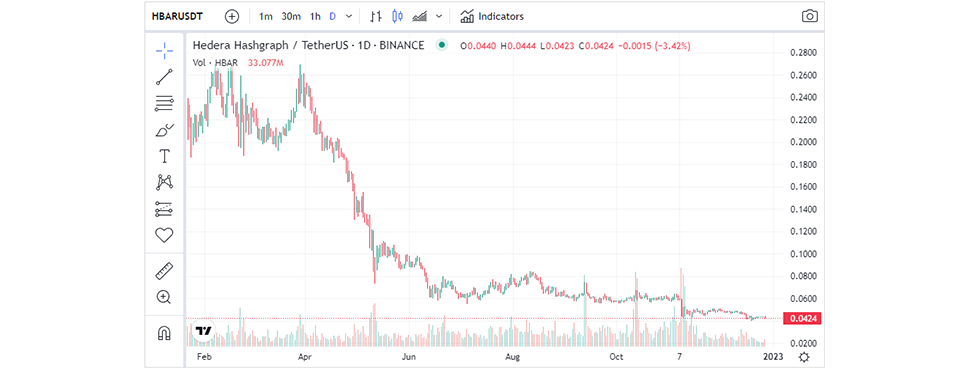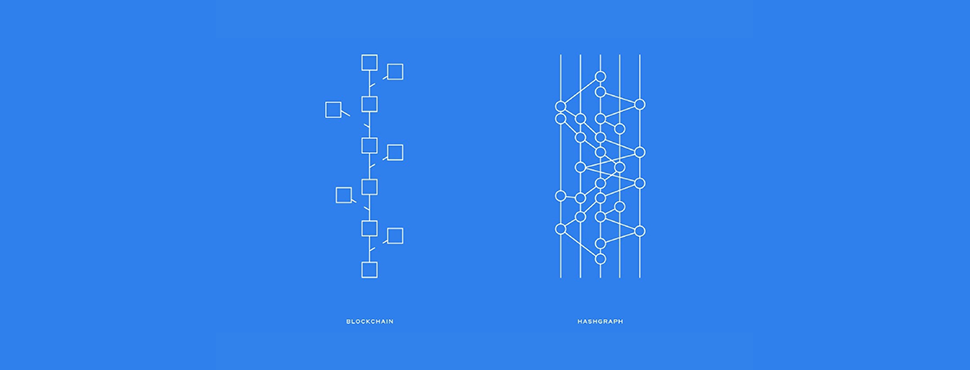share
There is very little doubt in anyone’s mind that blockchain technology possesses numerous advantages of various kinds when compared to some of the traditional systems of data storage and logging. The blockchain is surely a revolutionary system, and thus it has prompted hundreds of thousands of offshoot distributed ledger technologies, some of them extremely unorthodox and outside-the-box, claiming to be tremendously better and incredibly faster blockchain alternatives, for example, much more energy efficient at a markedly higher transaction speed that uses much less computing power as an end result. Perhaps, one of the most promising projects, and surely the most well-developed, is Hashgraph, which we are going to be looking at and talking about in today’s crypto-themed article.
How Is Blockchain Structured?
The correct answer is in the name itself, it’s fairly obvious, actually: it’s a very long line of roughly equal-sized data and information blocks, each of which holds some very sensitive (or not really sensitive, maybe it’s just someone’s grocery list, it could be anything at all, use your imagination) information about the previous block that can store data, including sensitive data, so the entire blockchain network is thus mapped in a fairly linear fashion. These blocks that make up the first 50% of the two-component term “blockchain”, are created by diligent miners who work day and night to verify transactions against the entire multi-year history of that particular blockchain (assuming it has been around for multiple years, of course) in order to prevent double spending and a lot of other shenanigans beyond your average human’s comprehension. With every block that is created by the good diligent miners, truly the unsung, but glorious heroes of blockchains all over the world, they get a reward for supporting the blockchain network. This is exactly how the energy-costly and disgustingly anti-environment Proof of Work consensus algorithm keeps its participants contributing their dirty computing power to the network, ruining the planet for generations to come.

What Is the Problem With Blockchain?
Blockchains that are built upon the Proof of Work consensus algorithm (and its derivative consensus algorithms, commonly referred to as consensus something-something whatevers) tend to only require more power as they mature into fully-fledged blockchains capable of interstellar flight across entire galaxies of imaginary metaverse crypto realms. Eventually, the entry threshold becomes high enough for decentralization to suffer and take a hit in the delicate, nether regions (which is very painful indeed, dare I say), making this system even more dependent for survival and function on central authority. Now, blockchain solutions to the famed Byzantine error are not standing on solid ground — or any ground for that matter: they are solutions, not people, and solutions have no legs, therefore they can’t stand in the true sense of the word, which is commonly used to describe positioning something upright, most often something with legs — for the fact that there is still a grave, even mortal risk that the majority of the system’s participants act on a whim and decide to turn against the very system they depend for financial gain, which sure sounds stupid, and it is, but that’s beyond the point of this worthless article. Bitcoin has already seen two major controversial hard forks, namely Bitcoin Cash (which also forked into Bitcoin Satoshi Vision and eCash), and Bitcoin Gold.

Hedera Hashgraph
Let’s first start with what we perceive to be the similarities between the two contenders in the battle of hashgraph vs blockchain that will undoubtedly leave no living thing in its deadly wake:
- Also a distributed ledger technology that is advanced and cutting-edge to the point where everyone looking at it starts bleeding from their eye sockets;
- Decentralized, and it’s always a good thing;
- A secure vehicle for sending sensitive data, or maybe not so sensitive, we haven’t quite asked if it even feels anything, so the point is moot.
The Hashgraph plays the same crucial role as Blockchain:
- Acts as a digital money system, the acting classes it took in Los Angeles were not lost on it;
- Supports and encourages sending and receiving payments, if you so desire;
- Facilitates decentralized, peer-to-peer-to-peer economy, that’s right, there are three peers now because two is a company, and three is a what? That’s right, three is a crowd, and crowds are a lot of fun unless you’re in downtown Delhi;
- Censorship-resistant, permissionless, and legless too, as we have discussed before.
How does the hashgraph vs blockchain fight look in practice?
- Speed: 50,000 times faster than commonly seen on blockchains. To put it in perspective, for every 7 blockchain transactions, hashgraph outputs 250,000.
- Efficiency: the amount of data generated by a running hashgraph is 60 times less than that of the blockchain. One doesn’t need several thousand dollars worth of hardware (so no need to go about your family asking for interest-free loans to buy GPUs at exorbitant prices only to see the market crash once you’ve finally assembled a janky mining farm in your grandmother’s basement) to start supporting the network, a simple Chinese smartphone is enough to handle the calculations. Whoops, I guess we’re going to see Xiaomi phone mining farms now!
- Reliability: the hashgraph network has asynchronous byzantine fault tolerance thanks to more rules on transaction processing, which includes grooming and coercing transactions into “please go through in time for my dealer not to go offline please”.
- Fairness: the hashgraph is designed to distribute mining rewards (including participation trophies, now that’s absolutely crucial in this day and age) more evenly between those who emotionally support the network. What would we be doing without these precious empaths? The crypto economy would be doomed, no doubt about it.
Hashgraph developers made it their goal to create a high-performance efficient alternative distributed ledger technology to the blockchain. Thanks to the brand new consensus algorithm and virtual voting system the network provides:
- High transaction speed – over 250,000 TPS.
- Fair rewards (calculated according to everyone’s contribution).
- Reliable operation through highly secure nodes in a highly interlocked network consensus.
Can hashgraph replace blockchain as the dominant distributed ledger technology? Well, the latter does offer robust decentralization, unmatched stability, unprecedented security, bulletproof immutability, and a fair level of anonymity. Now, the hashgraph network takes all that and builds upon it.
How Does Hashgraph Achieve That?
Some may say that hashgraph is standing on the shoulders of giants (blockchain), and they would be correct. It recognizes the pitfalls of the original distributed ledger technology and corrects them in its own way — Hedera Hashgraph algorithm has a more efficient method for treating new data, hence it’s faster at handling it than blockchain.
Blockchain mining is defined by competition: there could be thousands of miners trying to solve a block, but only one of them will eventually mine it — and reap the entire reward for himself. Hedera Hashgraph looks at transactions first and foremost, and every transaction is worth something.

Hedera Hashgraph vs blockchain
There is no mystery about the success of Hedera Hashgraph: it simply outperforms blockchains. But how? Let’s look at the main differences.
1. Speed
The hashgraph technology is built in such a way that it doesn’t require much computational power, and whatever it does, it utilizes in the best way possible — as opposed to the Proof of Work consensus mechanism, which is characterized by its wastefulness. To put it in perspective, Hedera Hashgraph can process 500,000 transactions per second when the Bitcoin blockchain can only handle about 5500 TPS.
2. Efficiency
Blockchains are built to enable secure transactions at the cost of energy efficiency. Generally speaking, blockchains output from 100 TPS to 10,000 TPS, depending on a range of factors.
The way Proof of Work blockchains secure the network, just a few thousand transactions end up taking quite a bit of energy and bandwidth. The associated costs are passed onto the user in the form of high fees for even the smallest of transactions.
3. Data Handling
Hedera Hashgraph relies on directed acyclic graph (DAG) to record transactions. This structure is the main factor that dictates the level of security and efficiency of its operation. The DAG is one of the special weapons of Hedera in the hashgraph vs blockchain battle. Blockchain technology usually adds new data on top of old data in a sequential manner, creating a hard-locked linear chain. All offshoot branches are ruthlessly pruned.
Unlike blockchain, hashgraph processes transactions simultaneously instead of sequentially. The system treats new data as “events” that are disseminated among all participants through the gossip protocol, and secures the integrity of that data via virtual voting. This ensures transaction speeds are high and data remains secure.
By relying on DAG, Hedera Hashgraph gains both speed and security, unlike blockchain technology that typically has to compromise either one of those things. The way transaction confirmation is handled in blockchains usually takes a lot of time so as to reach the required level of security.
4. Accessibility
Accessibility is also an important point in the hashgraph vs blockchain discussion.
Blockchains are relatively easy to implement for cryptocurrency platforms for the simple fact that they are freely available. Although not all distributed ledgers are like that, they are typically open source, which lends itself to wider adoption. On the other hand, Hedera Hashgraph is a proprietary, patented technology, the fact that has already sparked questions among the cryptocurrency community.

Does Hashgraph Have What It Takes to Replace Blockchain?
| Parameter | Blockchain | Hashgraph |
| Consensus | Participants get to mint new coins via consensus algorithms. | Nodes follow a voting-based consensus. |
| Transaction speed | Held back by systemic limitations (consensus mechanism, data structure). | Unique consensus mechanism requires little computation power, while featuring high scalability and TPS. |
| Data structure | Data comes in sequential blocks, each verified by miners on the network. | Virtual voting ensures the majority achieves consensus on the correct data structure. |
| Transaction verification | Miners get to decide which transactions get priority and which ones aren’t worth verifying at all. | Transaction verification is hard-coded to strictly follow consensus. |
| Networks using the technology | Bitcoin and Ethereum are the most popular networks built on the blockchain. | Swirlds and NOIA are the only networks currently built on the hashgraph. |
Despite offering a wide range of advantages compared to blockchain, hashgraph supporters would be hard-pressed to find real-world reasons for the newer technology to completely displace blockchain from the cryptocurrency space. The current trend seems to favor private blockchains. Various businesses are adopting the distributed ledger technology on their own scale at their own pace.
All of the above does not detract from the fact that Hedera Hashgraph is a promising technology that stands on solid ground and is entirely capable of growing into the next big thing.
The Future for Blockchain
Blockchain has already served as the foundation for a multitude of exchanges, investment funds, insurance companies, and banks. The number one use case for blockchain technology — digital money — is also seeing more adoption each year as people prefer crypto over fiat currencies for the many benefits the former provide, not to mention the budding crypto trading market.
The future of robotics and automation heavily relies on blockchain technology as an unhackable and immutable foundation for safe operation in the real world, so the king of decentralized technology is here to stay for the foreseeable future.

The Future for Hashgraph
Just as it has always been, whether old or new, technologies are striving towards higher efficiency, better performance, and lower costs. Almost every technology is eventually either made obsolete by a new one, or heavily modified beyond recognition, and there is no reason for us to assume that blockchain won’t share this fate.
Hashgraph sure holds a lot of promise in terms of security, efficiency, speed, decentralization, and more.
Some will say that there is nothing revolutionary about the hashgraph itself, and it’s simply a glorified combination of multiple sidechains and existing blockchain technologies. So far it’s been working, and we simply have to wait for it to manifest its potential in a tangible way. Perhaps, it just needs a few large businesses to believe in it for hashgraph to shine and prove to the world that it’s worth its while.

Conclusion
The cryptocurrency space has already seen numerous distributed ledgers claiming to be better than Bitcoin and addressing its scalability issues with their incredible throughput and efficiency. These blockchain solutions have, much more often than not, consequently failed to deliver on their claims once met with as much as a smidgen of real-world usage (hence the wording is always “up to XXX transactions per second”).
Hedera Hashgraph is not the first distributed ledger technology that separates itself from blockchain. It’s also not the first one to use DAG (directed acyclic graph): think Byteball and IOTA. The DAG technology sure does boast impressive characteristics that make it stand out from blockchain: accidental forking tolerance and the ability to conduct instant transactions without having to wait for the next block.
Like most things in today’s increasingly complex world, hashgraph and blockchain will likely coexist — boring, sure — each catering to a different niche. That is, until a new contender with more advanced technology arrives to shake up the status quo.





![CONF3RENCE 2025: Leading Web3 & AI Event [Promo Code ICODA20]](https://icoda.io/wp-content/uploads/2025/06/6203-23-1024x580.png)



